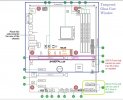britechguy
Well-Known Member
- Reaction score
- 4,854
- Location
- Staunton, VA
I've been installing/reinstalling Windows 10 since its first months of release, and what has occurred today is a completely new one on me.
A client brought in his gaming machine to have the NVMe M.2 SSD replaced (which, by the way, I have no idea of exactly why - I reinstalled Win10 Pro on it just for the fun of it first, and it checks out fine under chkdsk and all the S.M.A.R.T. stats), so I put in a new 500GB Crucial P1.
Did the usual clean install (Version 20H2 - ISO downloaded only a few days ago) on to an uninitialized drive, went perfectly, but when the machine boots up it's showing the menu to choose which Windows you want to start up and shows two different instances.
On the 1TB drive, after the first time it no longer did this. On the 500 GB drive, it's still showing that choice, but I have no idea why. It's not a huge deal, as I just set the default to the correct (first) instance and the timer to 3 seconds, but it's still very odd as far as I'm concerned.
Has anyone seen anything like this on a Windows 10 install to a brand spankin' new and uninitialized drive?
A client brought in his gaming machine to have the NVMe M.2 SSD replaced (which, by the way, I have no idea of exactly why - I reinstalled Win10 Pro on it just for the fun of it first, and it checks out fine under chkdsk and all the S.M.A.R.T. stats), so I put in a new 500GB Crucial P1.
Did the usual clean install (Version 20H2 - ISO downloaded only a few days ago) on to an uninitialized drive, went perfectly, but when the machine boots up it's showing the menu to choose which Windows you want to start up and shows two different instances.
On the 1TB drive, after the first time it no longer did this. On the 500 GB drive, it's still showing that choice, but I have no idea why. It's not a huge deal, as I just set the default to the correct (first) instance and the timer to 3 seconds, but it's still very odd as far as I'm concerned.
Has anyone seen anything like this on a Windows 10 install to a brand spankin' new and uninitialized drive?

